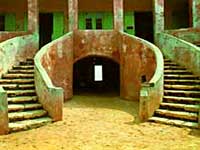Airport
Dakar-Yoff-Léopold Sédar Senghor International Airport
IATA Code: DKRLocation: The airport is situated 6 miles (9km) from Dakar.
Time: GMT.
Contacts: Tel: +221 (0)33 820 0780.
Transfer to the city: Bus #8 transports passengers between the airport and the city centre for XOF 250. The service is ony available between 6.00am and 9.00pm. Taxis are available outside the departures hall. Taxis fare into the city is XOF 3000 during the day and XOF 3500 at night. Taxi drivers often insist on XOF 5000, to avoid this passengers are advised get a taxi on the road outside the airport. Hotels often arrange transport for their guests.
Car rental: Car rental agencies represented at the airport include Hertz, National, Avis and Senegal Auto.
Facilities: Facilities at the airport include a bureau de change, restaurants, duty-free shopping and a tourist help desk.
Parking: Short- and long-term parking is available.
Departure tax: None.
Website:
Visit worldtravels.com for the full guide to Dakar. Build a complete Dakar travel guide and email to your clients - sign up for a trial subscription of World Travels Pro.
Dakar

After three centuries of French colonial rule, Senegal became independent in 1960. Before independence the city of Dakar was the capital of French West Africa, which included nine French-speaking states, and Dakar has been the capital of the independent Republic since then. The country retained strong ties with France and the French influence remains in the architecture of the city, where well preserved colonial buildings, the monumental government house and café terraces stand testimony to its history.
Situated on the tip of the Cap Vert Peninsula, the modern capital teems with life and boasts luxurious hotels, a wide range of restaurants, beaches and watersports, a casino and an active nightlife scene. It is also one of the busiest ports for cruise ships in Africa.
As the nearest African country to the United States, Senegal became the most important slave depot in West Africa and the island of Gorée, just two miles (3km) offshore, was the centre of the slave trade. For nearly four centuries thousands of men, women and children were kept locked in cells on the island, the 'Door of no Return', before being shipped to the Americas. Today Gorée is a UNESCO Historical Monument and visitors can experience the horrors of its past in 'La Maison des Enclaves' with its cells, shackles and the slave dealer's apartments, as well as at the many museums housed in former slave houses, and the forts built to protect the lucrative business.







